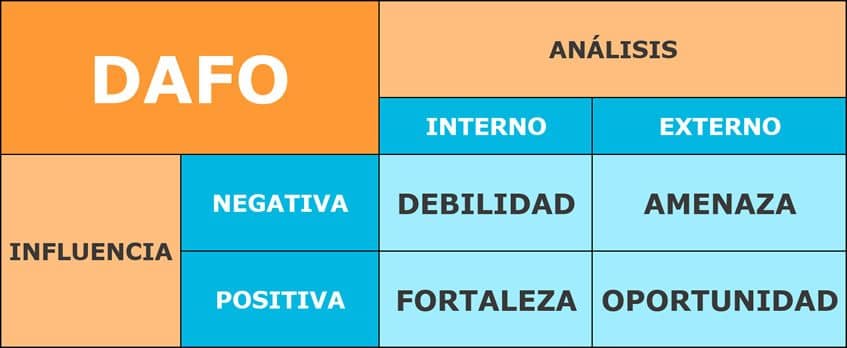Is diagnostic tool, known as SWOT (also called SWOT or SWOT) is basic in the strategy empresarial. His analysis is used in multiple circumstances. For the correct creation and implementation of a business strategy, the creation of a SWOT will indicate the way to proceed and the investment and financing decisions essential to take to achieve the profitability established in your objectives.
We recommend, before taking any type of decision, do a SWOT to:
- A business.
- A new Line of business.
- You Personal development.
In this post vas a aprender a how can you do a SWOT correctly for use in different situations. You will especially see what is it for that analysis and what decisions can we have with the. We will also teach you how to do the SWOT or SWOT with an example included.
SWOT is possibly the most widely used basic business strategy tool
What is SWOT analysis?
The SWOT analysis, also known as SWOT turns out to be the acronym for: Dabilities, TOmenaces, Fortalezas and ORportunities
It consists of a tool for analysis, which is represented by means of a square matrix like the one we will see next in this SWOT analysis example:
<>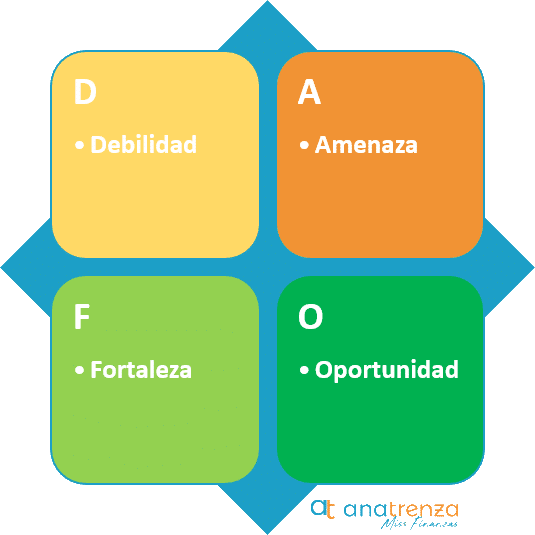
Elements of SWOT analysis
The SWOT or SWOT analysis of a company makes an assessment of elements such as internal and external factors that impact a business, draft or person.
- Weaknesses: it is internal activities or resources that give problems or lack.
- Strengths: They are the internal activities or resources that add value to your product or service.
- Threats: those external factors that it negatively affects.
- Opportunities: It is the external factors that it positively affects.
Therefore, we can imagine SWOT as a dual input matrix where we will have:
- Variables of scope (internal or external)
- Variables of influence (negative or positive)
What is SWOT analysis used for?
The target principal es determinar una foto en un momento determinado about the current situation de la empresa/proyecto/persona y que te be útil para design strategic decisions, with the purpose of comply set goals.
Types of SWOT analysis
From our point of view, it is not correct to speak of types "types", since the way to build a SWOT is basically just one (weaknesses, threats, opportunities, strengths). The only different thing will be to adapt it to each thing you have to take a decision. For example:
- A business.
- A specific department.
- A new line of business, to assess its viability.
- You Personal development.
A SWOT is usually an excellent starting point, before taking any steps.
SWOT analysis features
What requirements should a situation analysis have?
- Simple and easy to apply.
- Concrete, Unfilled. Detailed analysis.
- Overview of the situation of the company, project or person.
- To be critical and avoid biases.
- Revision periodic, to check deviations and make improvements
What is SWOT analysis for?
Many wonder What do I get by doing a SWOT?. This tool is used to study the way the internal and external factors may influence, either way positive or negative, About you business, you draft or your own person.
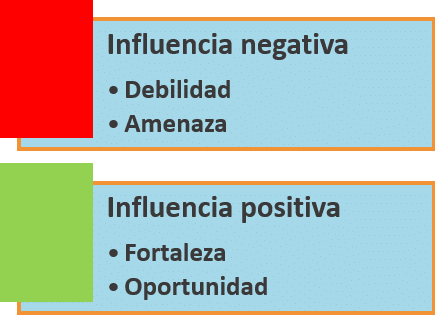
Advantages of SWOT analysis
From the information collected you can take decisions to improve your negative factors or take advantage of your positive factors. Together with PESTEL analysis, you will have the complete vision of your company.
- Full perspective.
- Identification of barriers automatic way.
- Anticipation to your problems.
- Creation of contingency plans.
- Saving of time and money when making corrections.
- Implement the idea of continuous improvement.
How to do a SWOT analysis of a company?
To perform an example SWOT analysis you only have to list the elements corresponding to each quadrant in the following Grid:
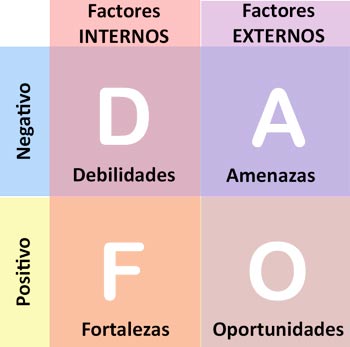
📥Descargar plantilla Excel de Dashboard SWOT
First step: internal analysis
The first step is he internal analisis with which we will detect capabilities (strengths) and limitations (weaknesses) existing in the organization / person that generate an advantage or disadvantage competitive.
The more complete and less biased the analysis, the better the results will be.
What is the true added value of each department? Where do we most often fail?
With these elements identified, we proceed to analyze the external position of the company:
- Weaknesses: Are the points to improve what are hurting you positioning frente a los competidores.
- Strengths: These elements are what make you really good, and make you more desirable than your competition. They determine your value proposal.
Where to start ?:
- Executive Direction:
- Organizational structure.
- Control procedures.
- Company culture.
- R&D.
- HR:
- Selection and recruitment.
- Motivation and Retention.
- Remuneration system.
- Rotation.
- Emotional salary.
- Production:
- Productive capacity.
- Costs: purchasing, manufacturing and logistics.
- Quality Standards.
- Technological innovation.
- Sales:
- Product lines.
- Pricing.
- Incentives
- Sales team.
- Marketing:
- Image, positioning and market share.
- Communication strategy.
- Post sale.
- Finance:
- Cost effectiveness.
- Treasury.
- Financing.
Tools to do the internal analysis
How can we do the internal analysis of a company?
- Value chain: With this tool we will determine which departments carry out the key activities of your company, the tasks that add value to your products or services and are reflected in the result of your company.
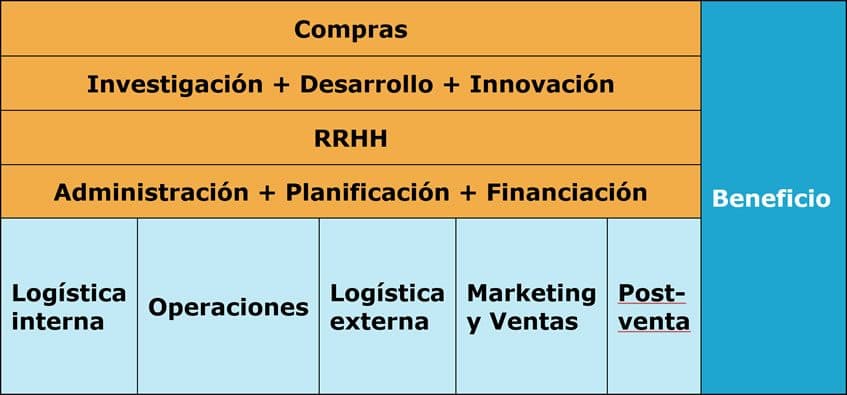
- ARC or Analysis of Resources and Capabilities: we could define it as an introspection of the potential of the resources and capabilities de tu empresa, estos son los que te proporcionan una competitive advantage sostenible y te permite resaltar por sobre tu competencia.
Questions to be answered for the internal analysis
Questions you can ask yourself for the internal analysis of your company's SWOT:
-
- What does the market perceive as my weakness?
- Why are they buying from me?
- What can we improve?
- What should we stop doing?
- Do I have exclusive resources?
- What does the market perceive as my strength?
- What elements detract from my sales or profitability?
- What are my competitive advantages?
Second step: external analysis
The second step is about External analysis, in which we will study the general environment and competitors to prevent and deal with possible threats and take advantage of all the possibilities that may arise.
- Threats: They are elements of the environment that could make it impossible for your company to carry out a strategy, by increasing risks, increasing the resources required, reducing expected income or reducing its profitability.
- Possibilities: They are those surrounding circumstances that presuppose a competitive advantage for the company and an opportunity to boost profitability or increase sales.
Can divide the environment in 3 levels:
- Environment general.
- Context of market and sector.
- Competence.
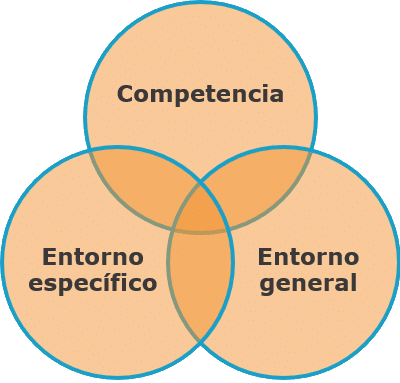
Tools for external analysis
The tools that are usually used for internal analysis of a company are:
- PESTEL analysis: you will analyze how the different external factors to your company, such as the political, economic, socio-cultural, technological, ecological and legal.
- Porter's 5 Forces: with it you will analyze the level of competition of your sector and the ability to negotiate with your suppliers and customers.
- Analysis marketing mix de competencia: of the competitors current, potential and referents.
Questions to be answered for the internal analysis
Questions what can you do for him External analysis of SWOT of your company:
-
- What are my chances now?
- Do the trends favor me?
- How does the economic situation and social trend impact?
- What technological changes can benefit me?
- What barriers do you face?
- What market trends are hurting me?
- What is the competition doing?
- What technological changes can harm me?
Examples of SWOT in companies
Here is a list of practical examples of companies. Perhaps you can take them as ideas and build on them to find elements in your own analysis.
How to do a personal SWOT analysis?
Although it does not seem necessary that you do this analysis at the personal, It is widely used in personal development.
In the same way that you analyze your company or project, you must recognize your features personal, attitudes and capabilities that encourage or hinder the fulfillment of your personal goals.
Do not forget that the success of your company or project depends directly from your personal situation, for this, you should take care of yourself and worry about being well.

Make a Personal SWOT will usually help you watch if you are in a good or bad time. Which, is influencing directly in all decisions professional and business that you do.
The personal SWOT will help you get to know yourself better and improve your weak points.
The methodology is always the same as the one you have used for your company.
How to do a personal SWOT?
- First step: To begin, perform a internal analysis about you, study what are your characteristics to improve (weaknesses) and what are your characteristics strengths.
- Second step: Then perform a external analysis about you, that is, study what threats and possibilities you can find in your environment.
The important thing here is that evaluate in depth. This will help you determine a strategy to follow and be prepared for new challenges personal and professional.
Questions to answer
Questions you can ask yourself for the personal SWOT analysis:
-
- What can I improve?
- What things am I not good at?
- What learnings can help me?
- What barriers do you face?
- What trends in my environment harm me?
- What do others perceive as my weakness?
- How do my weaknesses impact my relationships with others?
- What am I good at?
- Why am I good at doing what I excel at?
- What do others perceive as my strength?
- How do my strengths impact my relationships with others?
- What are my chances now?
- What trends in my environment favor me?
- How does the economic situation and social trend affect me?
- What technological changes can harm me?
Example of a personal SWOT analysis
Example of a personal SWOT analysis for an entrepreneur You have recently completed your training and want to develop a business idea that you have not yet clearly established.
-
- Without work experience.
- No business experience.
- You don't have an established business idea.
- Impatient.
- No specialized training.
- No training in business administration.
- No network of professional contacts.
- Penniless.
- University education or higher degree.
- Great motivation to undertake.
- Many ideas to develop.
- Young and energetic.
- Bad reputation for being independent or independent.
- Bad reputation as an entrepreneur.
- High competition in entrepreneurship.
- Excited for your project.
- No family responsibilities.
- No finance charges or debts.
- Positive attitude.
- Without fear of trying and failing.
- Interested in improving your training.
- Expert in the use of new technologies.
- Create a personal brand.
- Create a specialization.
- Easy access to the digital world.
- Multitud de herramientas de digital marketing.
- A multitude of digital management tools.
- New growth sectors.
- Moment of change in all sectors.
- Financial aid to support entrepreneurship.
- Recession business cycle.
- Lack of financial assistance.
What to do after performing a SWOT analysis?
With the SWOT analysis of your company, you should know how to use that info to get the most out of it. Before making a choice, you need to know the types of strategies that are out there and you can apply.
Types of strategies
Here are some strategies you can use
Retargeting strategy
The retargeting strategy have as main objective solve any soft spot taking advantage of a chance.
Improve an internal problem to access an external opportunity
Example:
- You are shy in public:
- They offer you the possibility of giving a talk in an association of young entrepreneurs: Chance.
- Conclution: you take advantage of a possibility to boost one of your weaknesses
Survival strategy
The survival strategy aims to overcome an unfavorable situation as best as possible. Faced with an external threat, if we do not have the necessary internal forces, we leave things as they are until the storm passes.
Example:
- Competitors have an aggressive pricing campaign in their store network:
- You do not have a large enough commercial network
- Conclution: You wait for the competition to finish their campaign, without getting into a price fight.
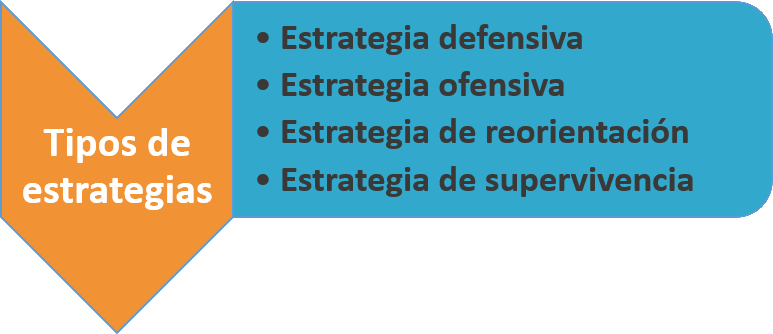
Offensive strategy
The offensive strategy has aim to achieve the maximum possible profit of an opportunity through the use of a fortress.
The company must adopt growth and improvement strategies when the context is ideal to do so.
Example:
- Sales begin to grow, because customer service is highly valued and your brand begins to be strong in the market:
- Your competitors have less sales force:
- Conclution: You launch an aggressive sales campaign to further increase the strength of your brand and wear down the competition.
Defensive strategy
The defensive strategy is generated when your company is ready to face threats thanks to the use of your strengths.
You face external threats with all your internal forces, which are capable of leading you to victory.
Example:
- Your competition launches a new line of services that will complement:
- You have a highly action-oriented team of workers with adaptability and continuous improvement:
- Conclution: You launch a complementary line of services superior to that of the competition and you sweep the market.
Now you have one global vision what is the situation of your company and you will know Where is he now.
Once you know where your company is, you need know how to reach your goals, for this you must use the matrix CAME or cross SWOTso you will know what strategies you have to put it into practice.
What is the CAME matrix used for?
With the CAME matrix you will be able:
- Maximize, squeeze or take advantage of all possibilities and strengths.
- Minimize, reduce or remove all threats and weaknesses.
In this table you can clearly see which is the strategy to follow with each one of the characteristics that you have included in the SWOT quadrants.
- Fix weaknesses:
- Reorientation strategy.
- Facing threats:
- Survival strategy.
- Maintain strengths:
- Exploit the possibilities:
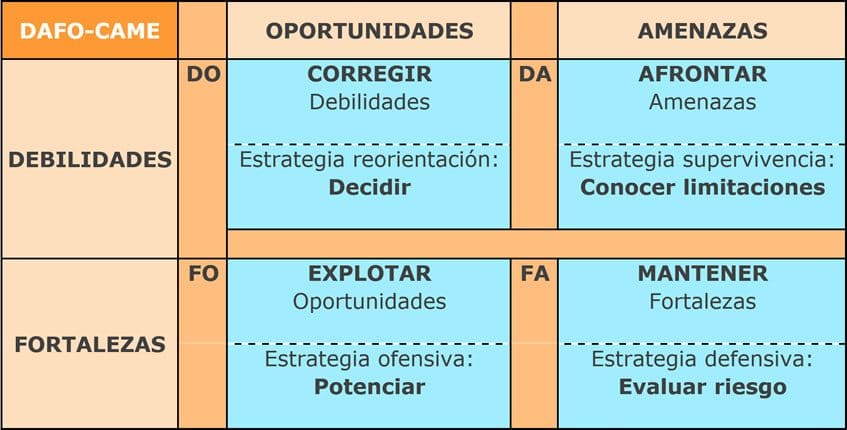
How to do a CAME-SWOT analysis
The CAME-SWOT analysis or crossed SWOT matrix is the table in which the internal analysis is crossed with the external one, that is, weaknesses and possibilities with threats and possibilities.
These are the basic steps to perform a CAME analysis:
- Determine a strategy that marks us what are the general objectives that we want to achieve in our organization. This is important because it helps us prioritize the actions to take in the next steps.
- Do a SWOT Analysis to obtain a situation diagnosis.
- Obtained the weaknesses, threats, strengths and opportunities, we select the most important
- Once the aspects on which we are going to act have been decided, we carry out the CAME Analysis. To do this, we select each of the previously selected weaknesses, threats, strengths and opportunities, and associate actions with them to correct, mitigate, maintain or exploit them, as appropriate in each case.
- Finally, it only remains to implement the actions and monitor them to check that our initial objectives are being met.
Its objective is to make decisions after the SWOT diagnosis:
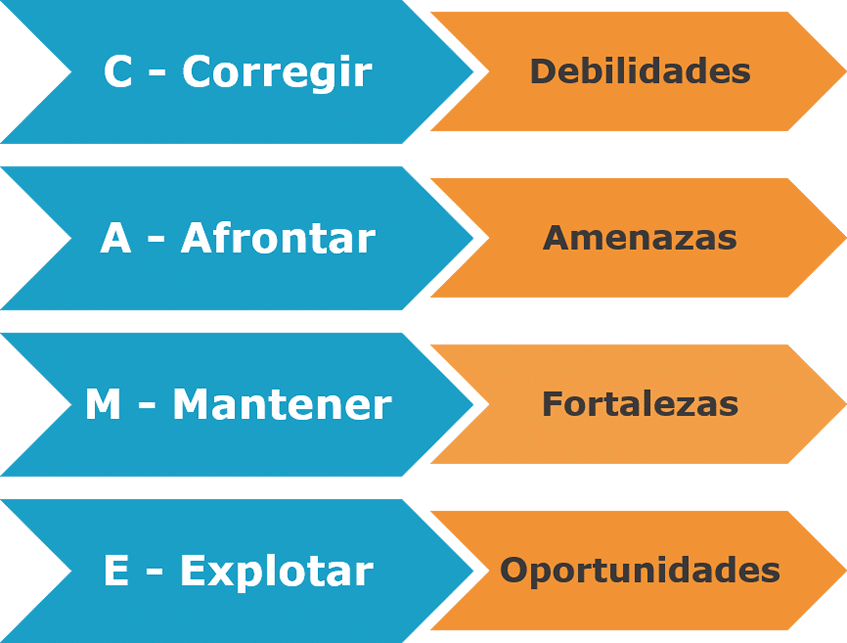
Last conclusions
The analysis SWOT it will permit you know your company. From its results you will be able identify the strategy you should follow to achieve all your goals.
Now you understand how to do the SWOT of your company, it is a basic tool for your business strategy, since it encompasses different basic investment and financing decisions to achieve the profitability established in your objectives.
We hope this post has been useful to you.


